科佩爾中央公園,斯洛文尼亞 / ENOTA
以與眾不同的形式和空間組織方式打破公園設(shè)計(jì)的既有規(guī)則
設(shè)計(jì)公司:ENOTA
位置:斯洛文尼亞
類型:景觀
材料:石材 混凝土
標(biāo)簽:Koper 科佩爾
分類:休閑娛樂 公園
科佩爾中央公園位于科佩爾大運(yùn)河旁的Piranska大街和Semedela長(zhǎng)廊之間,與城市市場(chǎng)相鄰。Piranska大街代表著科佩爾城市建設(shè)的新階段,而Semedela長(zhǎng)廊則是最富特色的街道之一,它曾經(jīng)是島嶼和陸地之間的一條紐帶,同時(shí)連接著海洋與海邊的鹽池。隨著城市在過去幾十年間的發(fā)展,原先的鹽池逐漸被填滿,重新被恢復(fù)的土地也為城市的發(fā)展帶來了巨大潛力。
New Koper Urban Park is set between Piranska Road and the Semedela promenade, and between the Grande canal and the area just beyond the city market. Piranska Road represents a new stage in the development of the town’s infrastructure while the promenade is one of the more important features of the town having once acted as the link between the city on the then-island and the mainland. As such, it counts among the characteristic elements in the panorama of Koper. The connection ran between the sea and the salt ponds. As the city developed during the past decades, the former salt-pond area was gradually filled in. The land thus recovered represented a major development potential for the town.
▼項(xiàng)目概覽,project overview
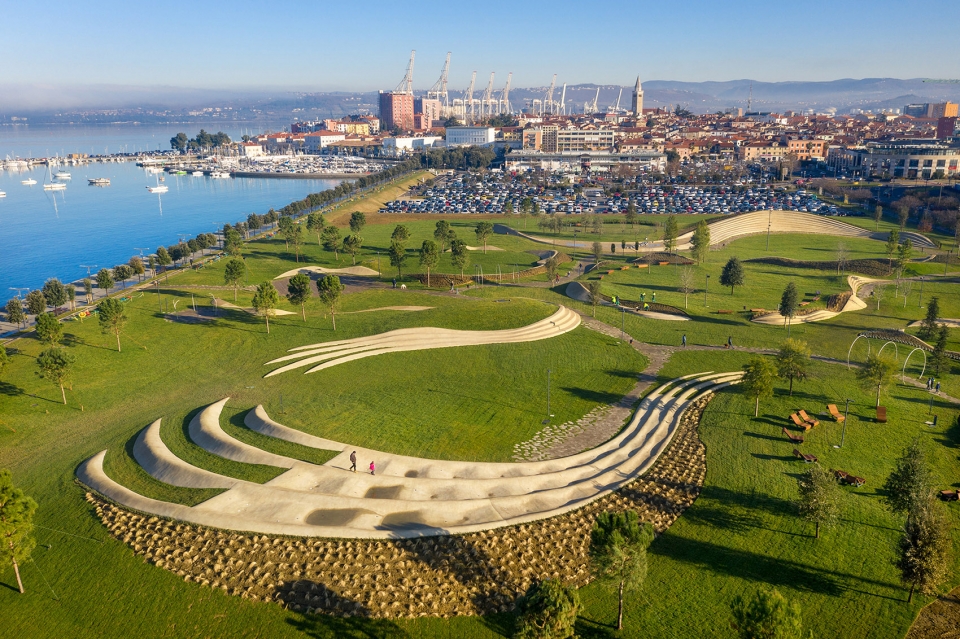
如今,這些被恢復(fù)的土地還有很大一部分未曾得到利用或仍在建設(shè)中。該項(xiàng)目所在場(chǎng)地的主要特征是它同時(shí)靠近街道和大海,這對(duì)于提高空間品質(zhì)而言有著十分重要的意義。與此同時(shí),它特殊的地理位置還使其成為了從科佩爾和伊佐拉兩個(gè)城區(qū)通向海濱區(qū)域的起始點(diǎn)。設(shè)計(jì)師需要對(duì)海濱長(zhǎng)廊進(jìn)行全面和綜合性的規(guī)劃,以便從視覺上和功能上將兩個(gè)獨(dú)立的城市區(qū)域鏈接為一個(gè)符合邏輯的整體。該地區(qū)需要通過適度的介入來激活科佩爾居民的日常生活,同時(shí)將舊城區(qū)與馬爾科夫山一帶的Semedela, Olmo和Markovec區(qū)域連接起來。
Nowadays, these surfaces are partially built, but there are still extensive unoccupied surfaces, including the area under consideration. The key characteristic of the area is the immediate connection with the promenade and the sea, which is to be recognised as a significant spatial quality. The area is partially occupied by a large car park behind the city market. In the broader context, the area represents the first contact with the sea for the visitors to the Slovene coast, and it represents the starting point of the riviera between the towns of Koper and Izola. Only a comprehensive and co-ordinated treatment of the entire belt along the promenade will be able to visually and functionally connect the two currently separate parts of the town into a logical whole. This area needs an intervention which will bolster the free-time activities of Koper’s inhabitants and further connect the old part of the city with the suburbs of Semedela, Olmo and Markovec, which are strewn across the slopes of Markov Hill.
▼新的公園將大運(yùn)河、舊城區(qū)和郊區(qū)連接起來,the new central park link the Grande canal with the old city and suburban areas
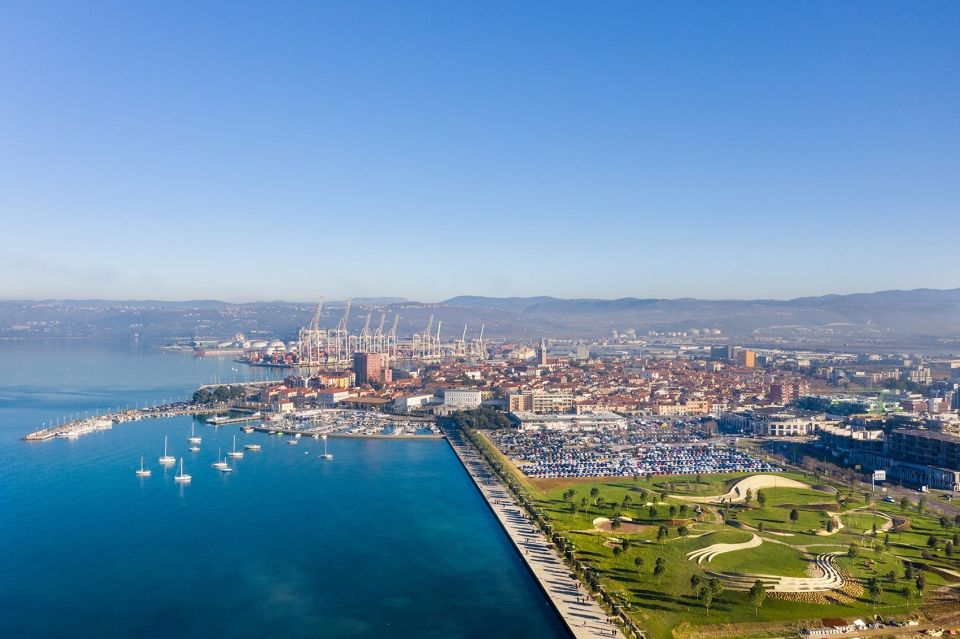
根據(jù)預(yù)測(cè),長(zhǎng)廊附近的海水的清潔度將會(huì)越來越高,這也將促進(jìn)新的城市海灘的形成。許多成功的案例均表明,城市海灘往往會(huì)成為居民們最重要的休閑場(chǎng)地和社交空間。密集發(fā)展的舊城區(qū)無法提供足夠?qū)挸ǖ拈_放空間,同時(shí)考慮到各類公共活動(dòng)可能對(duì)附近居民造成的干擾,設(shè)計(jì)團(tuán)隊(duì)決定打造一個(gè)內(nèi)向式的場(chǎng)地,為其在視覺上建立一定的“阻礙”,但同時(shí)又通過宏大的規(guī)模和尺度成為場(chǎng)地中極為特殊的存在,并借此將科佩爾的不同區(qū)域連接起來:包括舊城核心區(qū)、城郊住宅區(qū)、舊鹽池區(qū)以及商業(yè)開發(fā)區(qū)等。
In line with the prognosis that the sea by the promenade is to grow increasingly cleaner, it is feasible that a new city beach may appear along the promenade. Successful similar examples show that a city beach is not only an area where people take a dip in the sea but that city beaches can become the most important free-time socialising space. Since the densely developed old town core does not allow for a sufficient number of large open spaces and constrains their size, and since we need to understand that convivial bustle, concerts, and late-night events disturb the residents in the immediate vicinity, the placement of such programme in the area under consideration is all the more suitable. The heterogenous forms of development which characterise present-day Koper – the old town core, the residential suburbs, the commercial and service development belt in the former salt-pond area, and the inescapable presence of all the infrastructure required by a modern seaport call for a space with an inwardly oriented form enabling a visual escape, but whose scale and outward expressiveness would rise above the heterogeneity of development around it and tie it all together.
▼一個(gè)內(nèi)向式的場(chǎng)地,通過其宏大的規(guī)模成為場(chǎng)地中極為特殊的存在,a space with an inwardly oriented form enabling a visual escape, but whose scale and outward expressiveness would rise above the heterogeneity of development around it
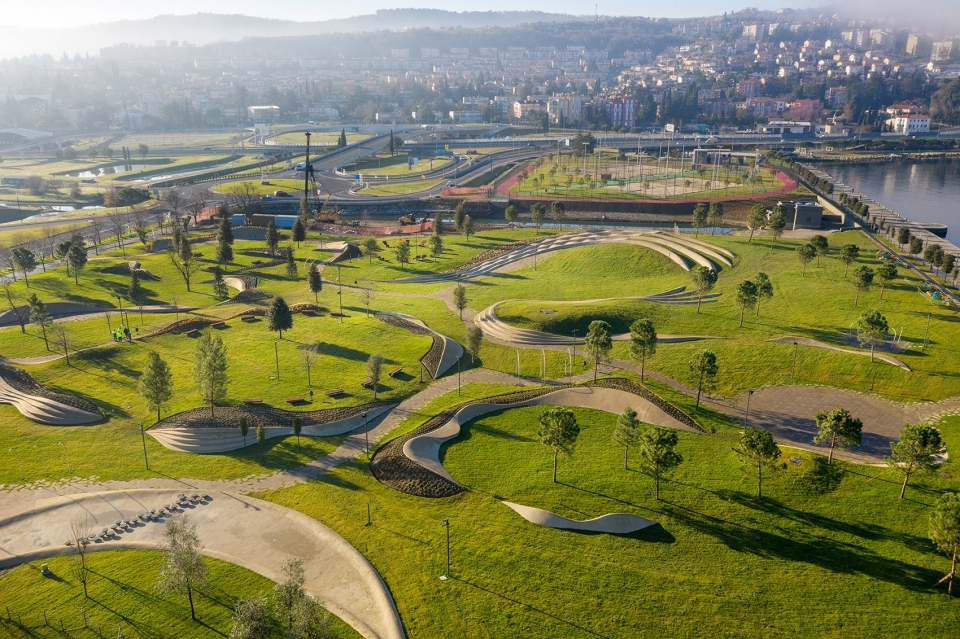
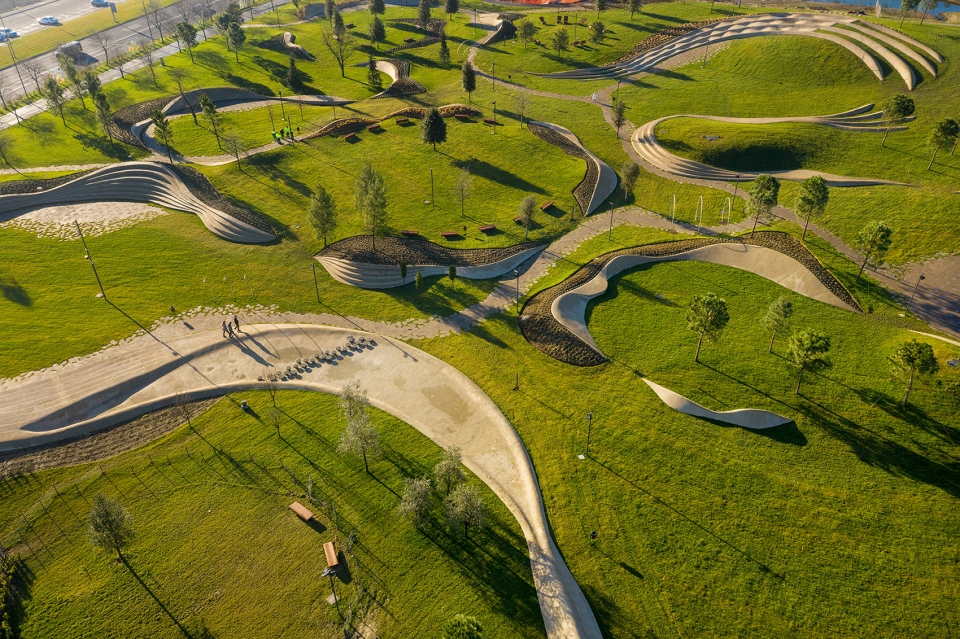
新的中央公園覆蓋了一個(gè)十分開闊的區(qū)域。借助密集的腹地綠化,公園被賦予了整潔而吸引人的外觀,同時(shí)還融合了城市海灘與現(xiàn)代化城市公園的元素特征,鼓勵(lì)當(dāng)?shù)鼐用褚圆煌问絽⑴c到空間的使用和體驗(yàn)當(dāng)中。
The area of the new city park covers a sizeable portion of the wider site and its design can thus serve as a prototype for further interventions. The new intervention offers a uniform and attractive appearance, and with its intensive hinterland greenery, it drowns the heterogeneity of the surrounding built structures. The fusing of the elements of a city beach and a contemporary city park encourages the area’s residents and visitors to use the space in different ways.
▼公園融合了城市海灘與現(xiàn)代化城市公園的元素特征,the new park fuses the elements of a city beach and a contemporary city park
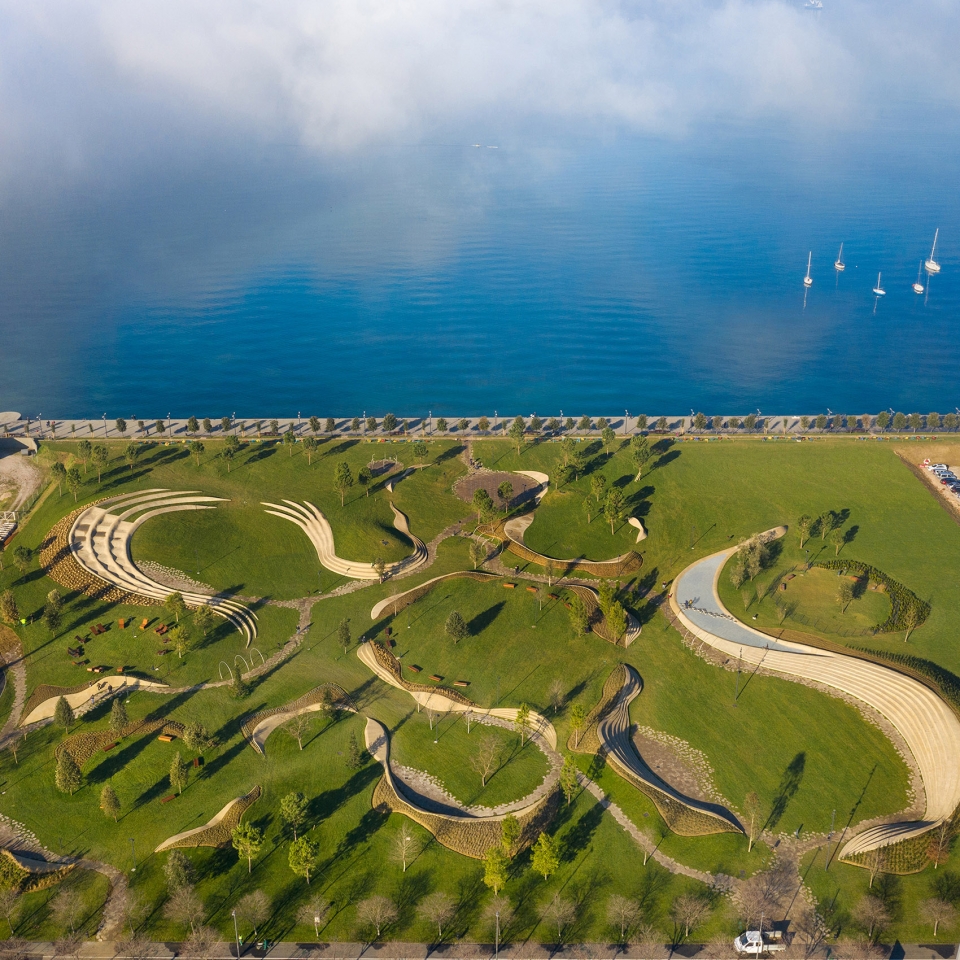
公園中新置入的建筑結(jié)構(gòu)是一系列有機(jī)而連續(xù)的整體,它們被精確地放置在場(chǎng)地當(dāng)中,與顯眼的綠色草地融為一體,將整個(gè)公園的表面柔和地劃分為一系列內(nèi)向式的小島。結(jié)構(gòu)的高度也根據(jù)使用需要而有所變化:在較高處,它們可以作為擋風(fēng)和隔音的屏墻;在低處,它們又能夠使不同的區(qū)域形成無障礙的連接。起伏的結(jié)構(gòu)在場(chǎng)地中形成了觀眾區(qū)、兒童教育區(qū)、攀巖墻、海濱酒吧背景墻、音樂會(huì)場(chǎng)地、兒童游樂場(chǎng)以及閱讀區(qū)等豐富的功能空間。
The basic building blocks of the new city park are monolithic, undulating urban elements. Their controlled placement in the space in combination with a pronounced topography of the green surfaces softly divides the whole of the park’s surface into individual introverted programme isles. The design of the individual urban elements consistently follows the different programmes. In places, they are taller and act as a shelter from views and the noisy surroundings; elsewhere, they are lower and allow for an unimpeded contact between programme zones. The organically designed urban elements form stands for viewers, an obstacle course for children, climbing walls, a backdrop to a seaside bar, a concert venue, a children’s playground, a reading area, and more.
▼公園中新置入了一系列有機(jī)而連續(xù)的結(jié)構(gòu),the basic building blocks of the new city park are monolithic, undulating urban elements

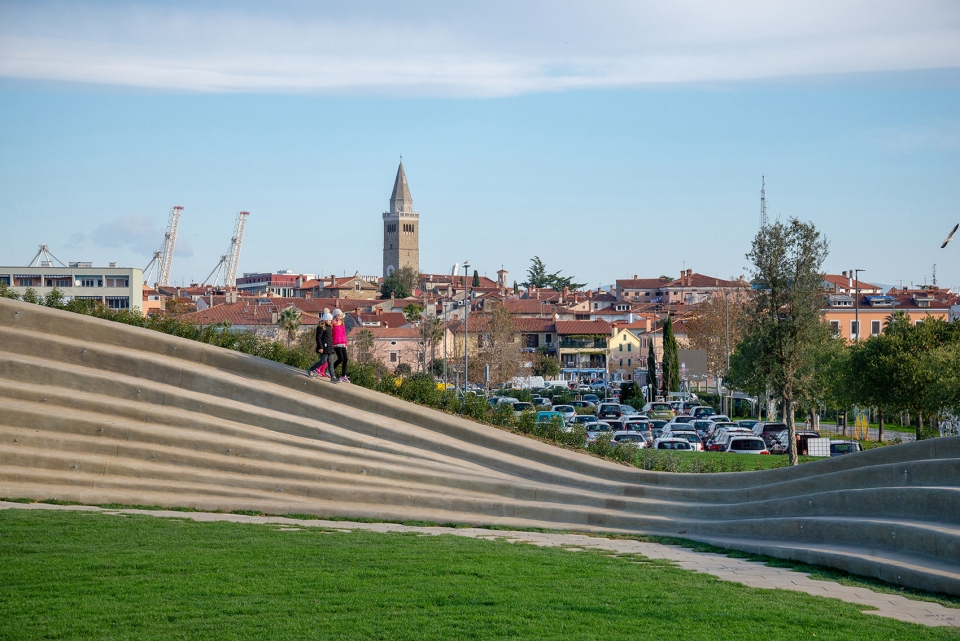
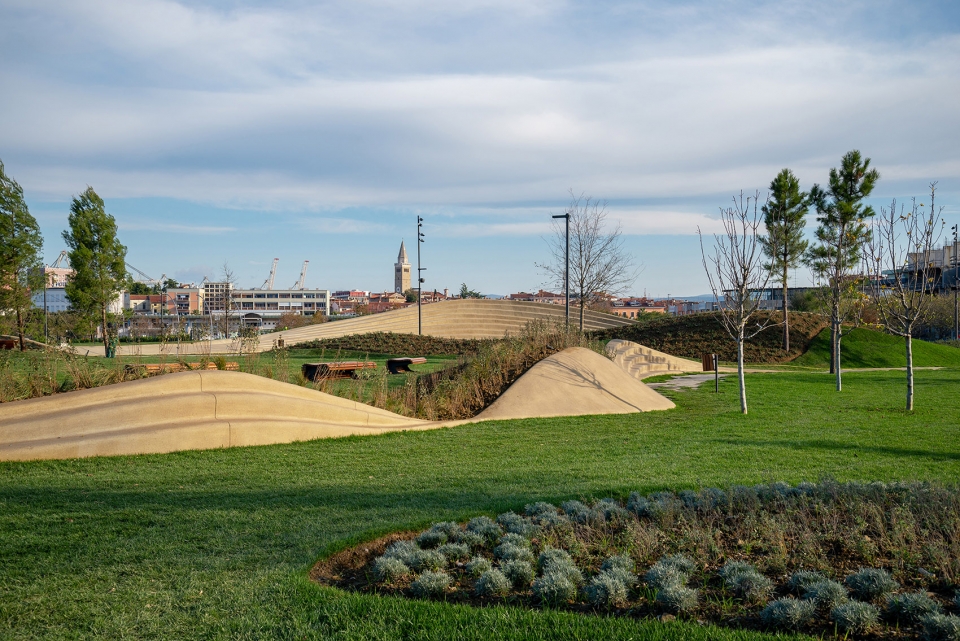
▼起伏的結(jié)構(gòu)將公園柔和地劃分為一系列內(nèi)向式的小島,the urban elements softly divide the whole of the park’s surface into individual introverted programme isles
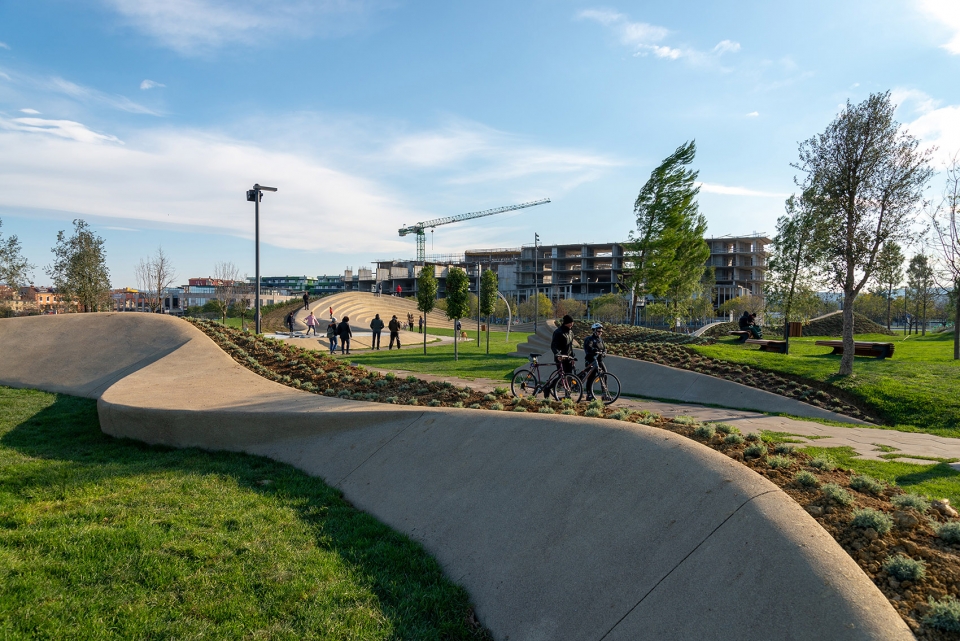
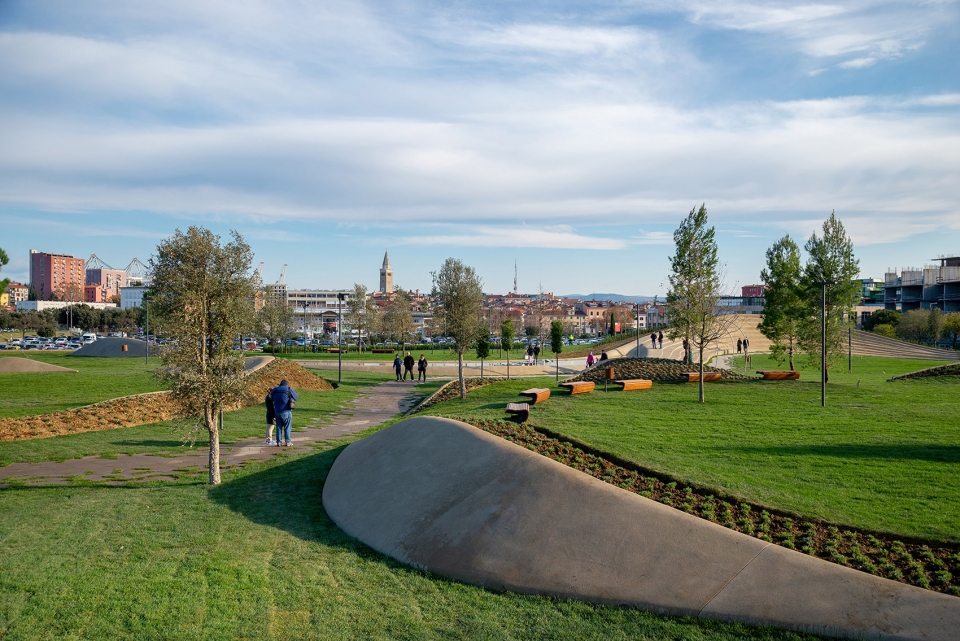

▼休息區(qū)域,seating area
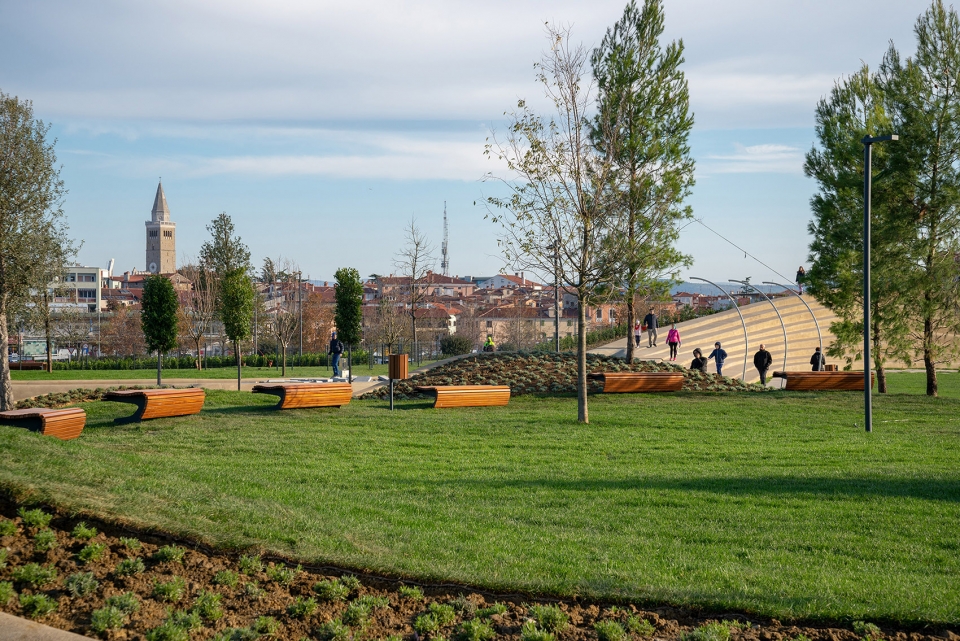
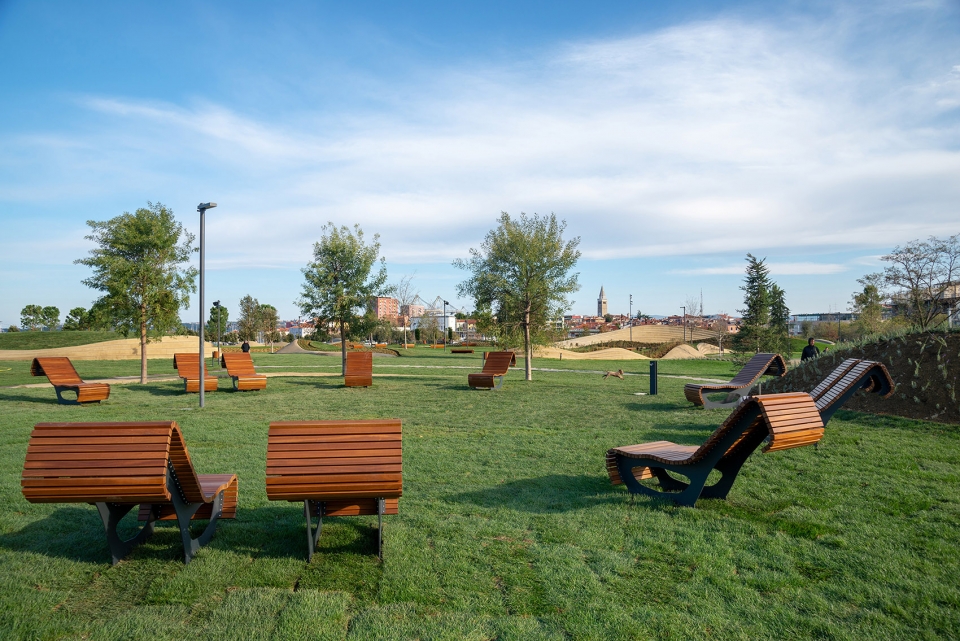
由于靠近大海,公園中包含眾多與水有關(guān)的元素,例如水池、地面灑水器、噴泉、拋物線花灑、小瀑布以及與建筑結(jié)構(gòu)相結(jié)合的水景平臺(tái)等。這些元素能夠促使人們積極地使用空間,并有助于在未來將沙灘區(qū)域擴(kuò)展至公園內(nèi)部。
Due to the proximity of the sea, the programme zones are appointed with numerous water elements. A pond, ground sprinklers, a geyser, parabolic water jets, cascades and a water platform in combination with the variegated urban elements encourage an active use of the space and an expansion of the future beach towards the interior of the park.
▼公園中包含眾多與水有關(guān)的元素,the programme zones are appointed with numerous water elements
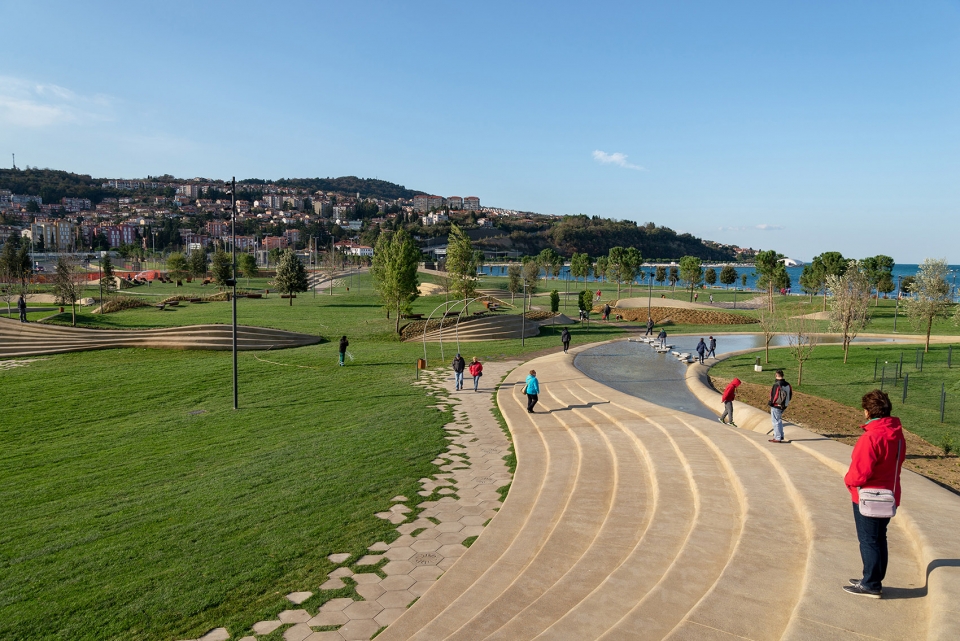
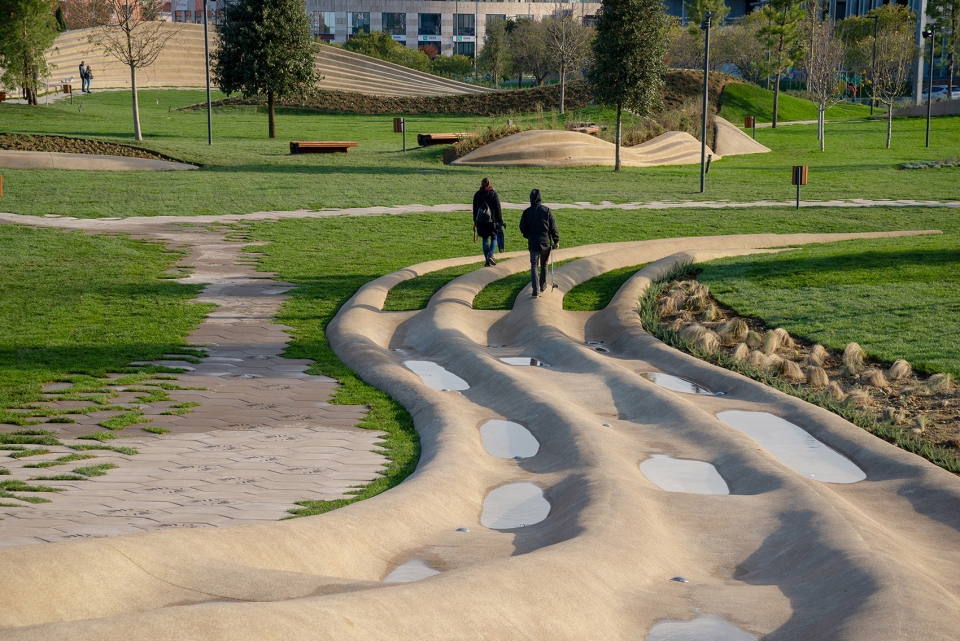
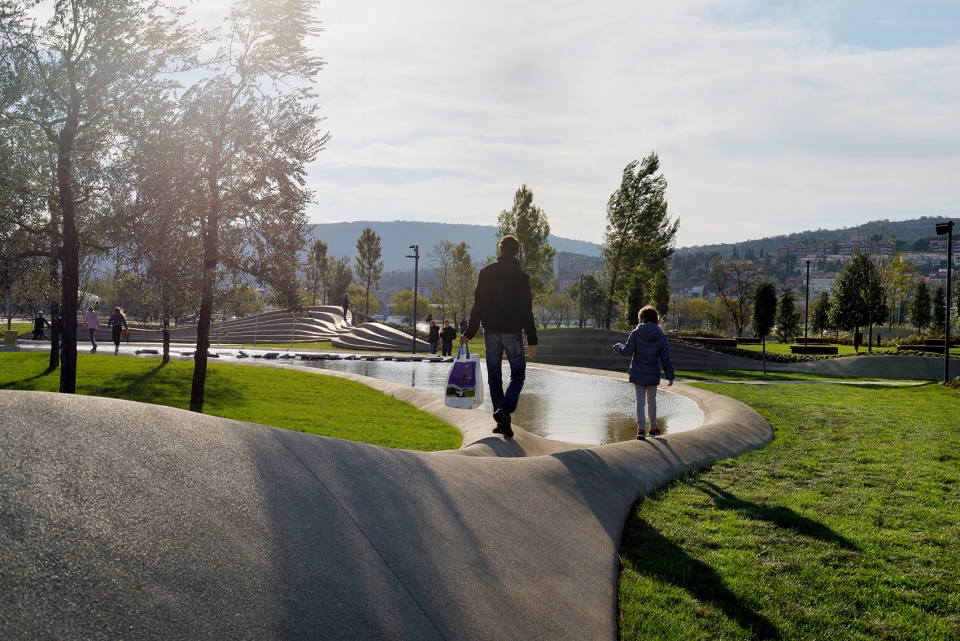

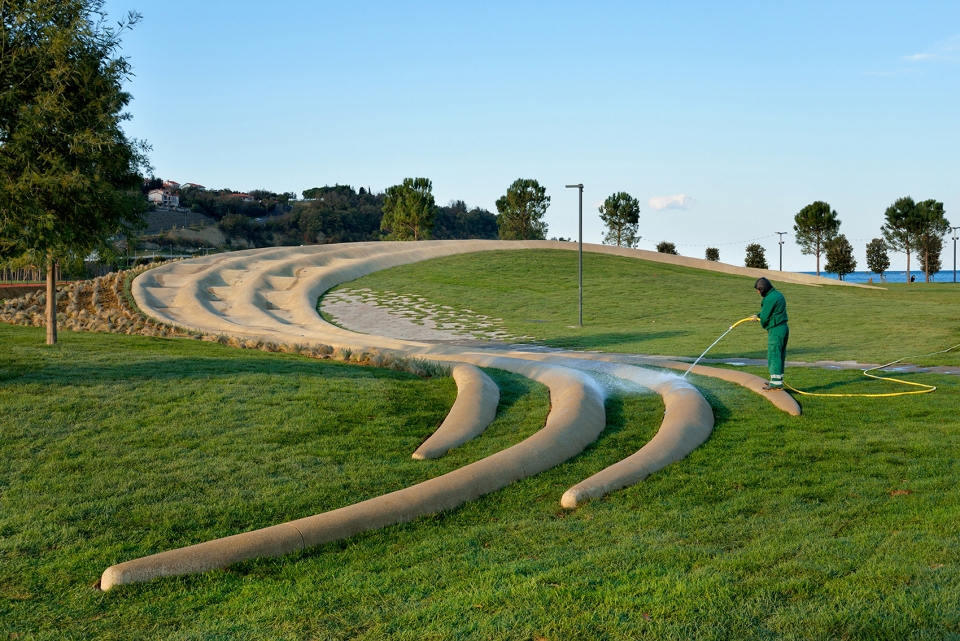
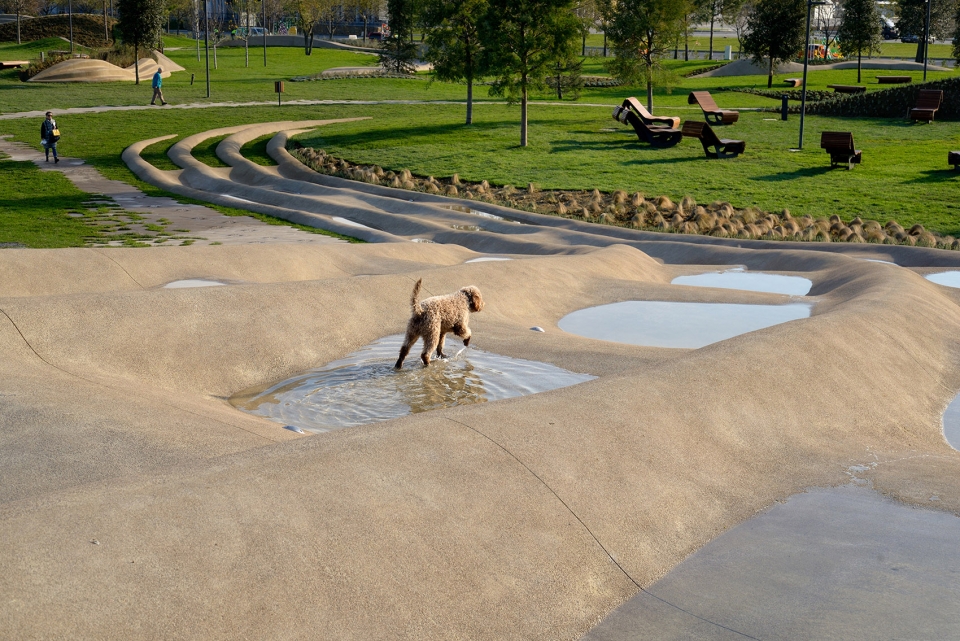
景觀中僅種植了本土的地中海植物。高大的樹木被策略性地排布在場(chǎng)地中,與公園兩側(cè)既有的樹木形成和諧呼應(yīng),不僅為功能區(qū)帶來了涼爽的蔭蔽,還為公園區(qū)域提供了一道額外的屏障,使其免于受到周圍環(huán)境的影響。
The planted portion of the landscape design is laid out only with indigenous Mediterranean vegetation. The strategically arranged tall growth complements the existing tree lanes on both edges of the park, gives shade to the individual programme zones, and offers the park area additional protection from the impacts of the surroundings.
▼本土的地中海植物被策略性地排布在場(chǎng)地中,indigenous Mediterranean vegetation is strategically arranged
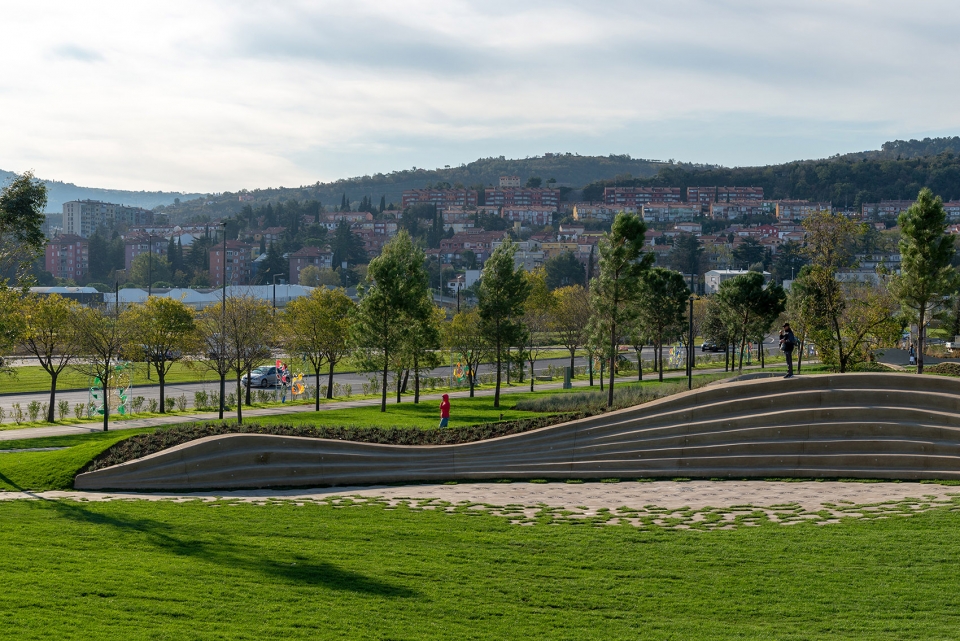
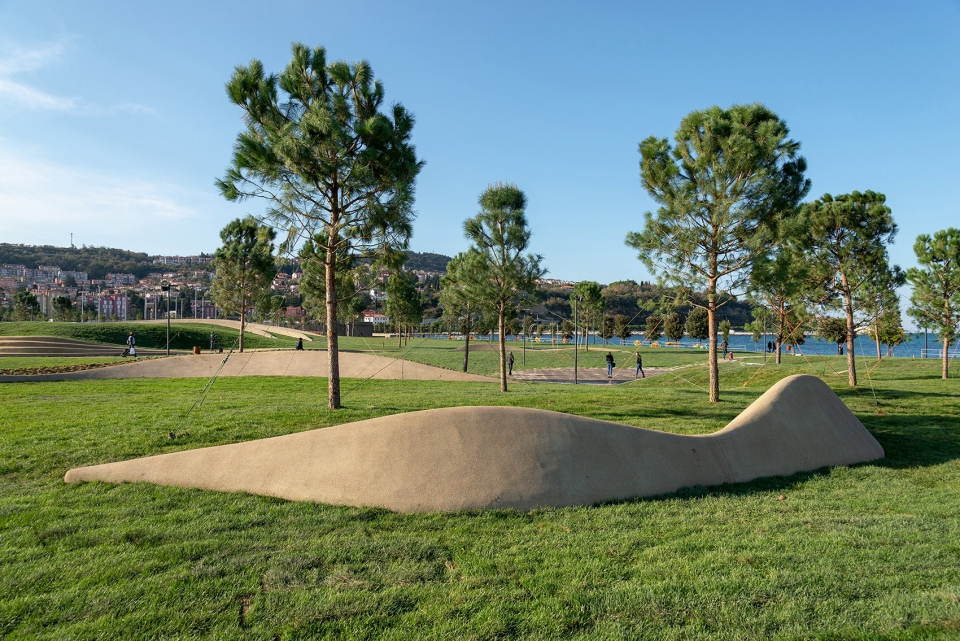
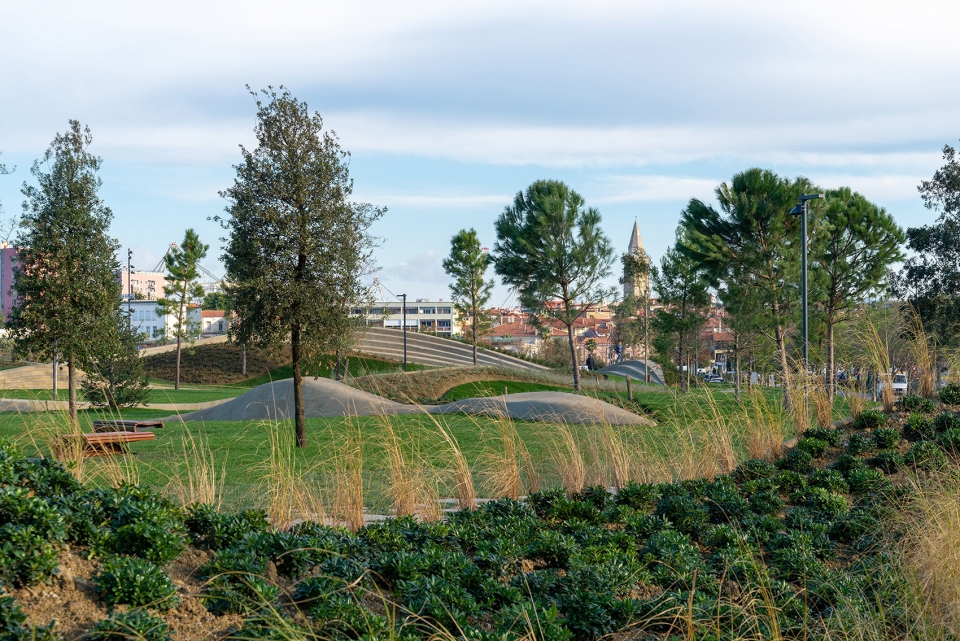
為了盡可能地增強(qiáng)空間在使用上的多樣性,公園中沒有設(shè)置傳統(tǒng)的步行路徑,而是在入口區(qū)和地面使用率較高的區(qū)域鋪設(shè)嵌入草坪的磚面,從而讓使用者自由地定義行走路徑。在未來,如果公園中要增加新的元素,這種鋪路的方法也有助于對(duì)場(chǎng)地重新進(jìn)行調(diào)整和布置。
In order to encourage as much diversity in the use of its space, the new city park doesn’t feature traditionally designed footpaths. Interlocking paving with a free arrangement of grass-coloured tiles is limited to the access points and the sections of the park where a more intensive use of the ground is expected. In this way, the visitors define their own path and their own manner of using the space. In case new content is added to the park, or if obvious desire lines are formed, which is very difficult to predict initially, this manner of paving enables an easy rearrangement of the compacted surfaces at a later time.
▼在入口區(qū)和地面使用率較高的區(qū)域鋪設(shè)嵌入草坪的磚面,interlocking paving with a free arrangement of grass-coloured tiles is limited to the access points and where a more intensive use of the ground is expected
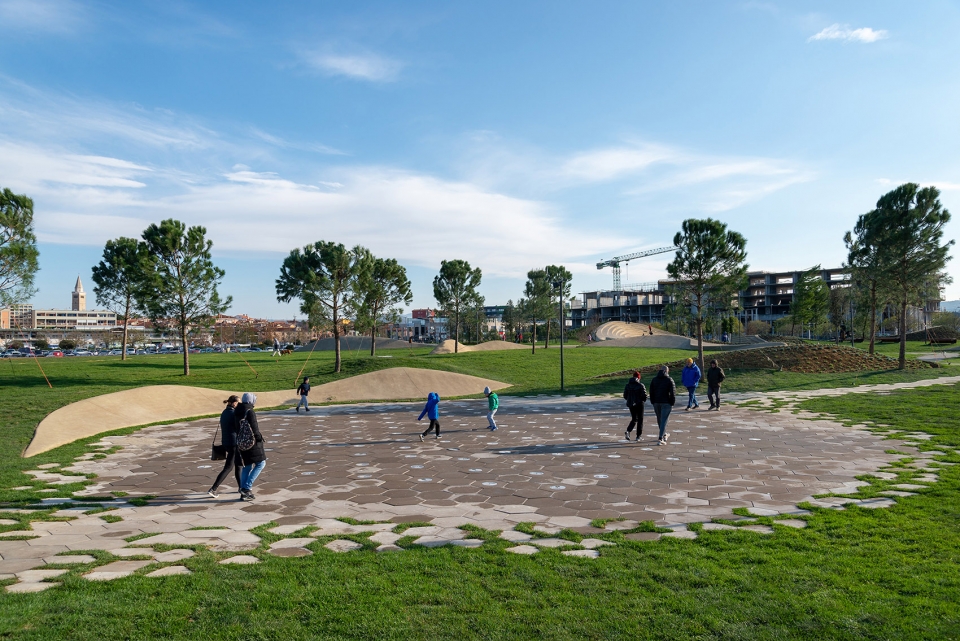
▼公園讓使用者自由地定義行走路徑, the visitors define their own path and their own manner of using the space
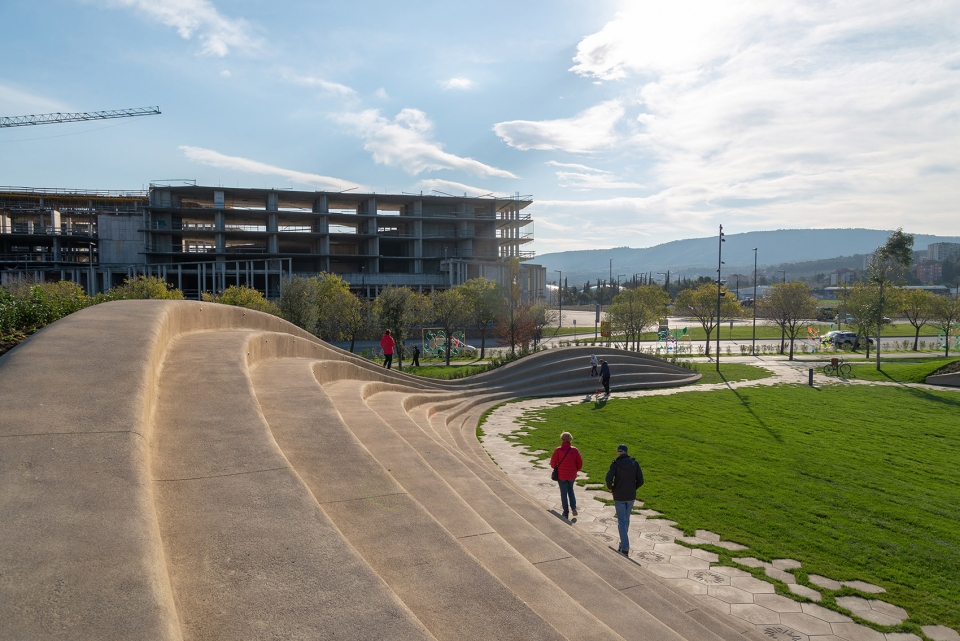
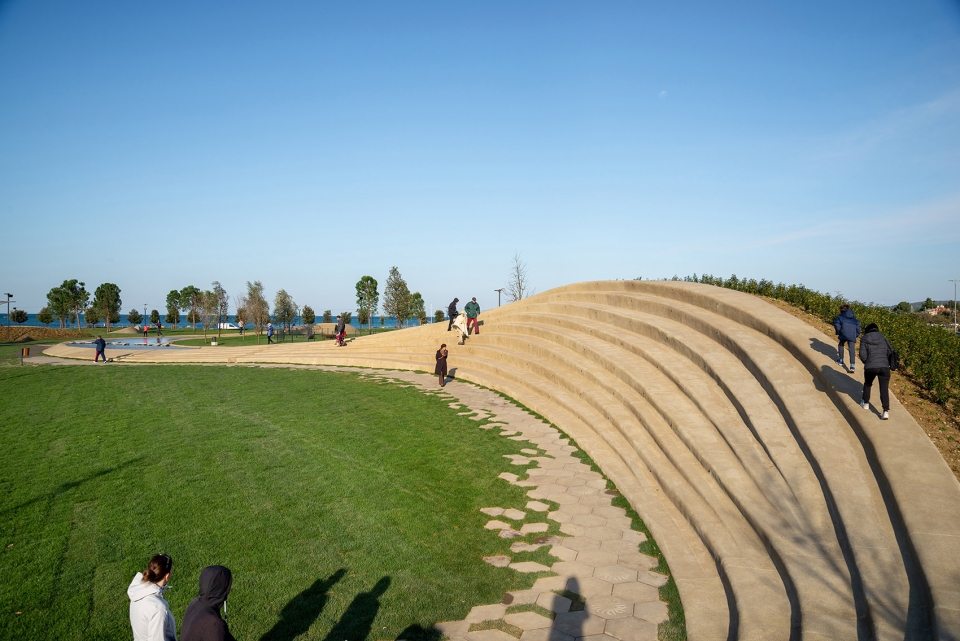
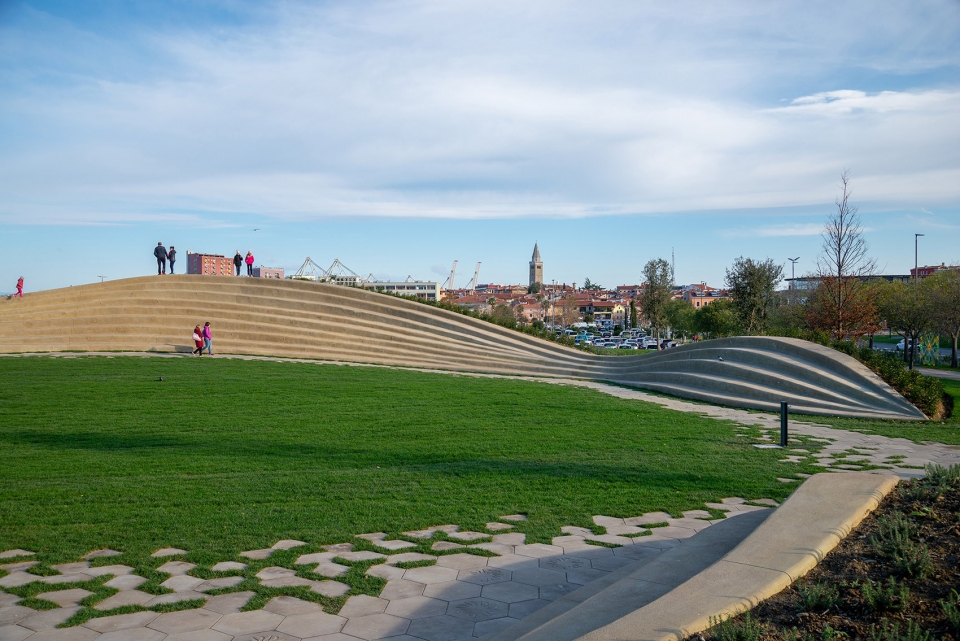
中央公園充滿創(chuàng)新的布局為科佩爾提供了一個(gè)受歡迎的新目的地。它以與眾不同的形式和空間組織方式打破了公園設(shè)計(jì)的既有規(guī)則。新的公園將為附近區(qū)域的進(jìn)一步開發(fā)提供適用性的依據(jù),同時(shí)也為斯洛文尼亞其他海岸區(qū)域的發(fā)展提供了一個(gè)成功的范例。
The innovative layout of the city park is a great new asset for the citizens of Koper as it enables the development of programmes which the city presently cannot offer. The new park is an attraction and with its unique form and the manner of spatial organisation, it transcends a merely functional park regulation. It represents a prototype for further designing of the wider area, as well as motivation for development-oriented attitudes in regard to other sections of the Slovene seacoast currently in a state of decay.
▼一個(gè)受到科佩爾居民們喜愛的新目的地,a great new asset for the citizens of Koper
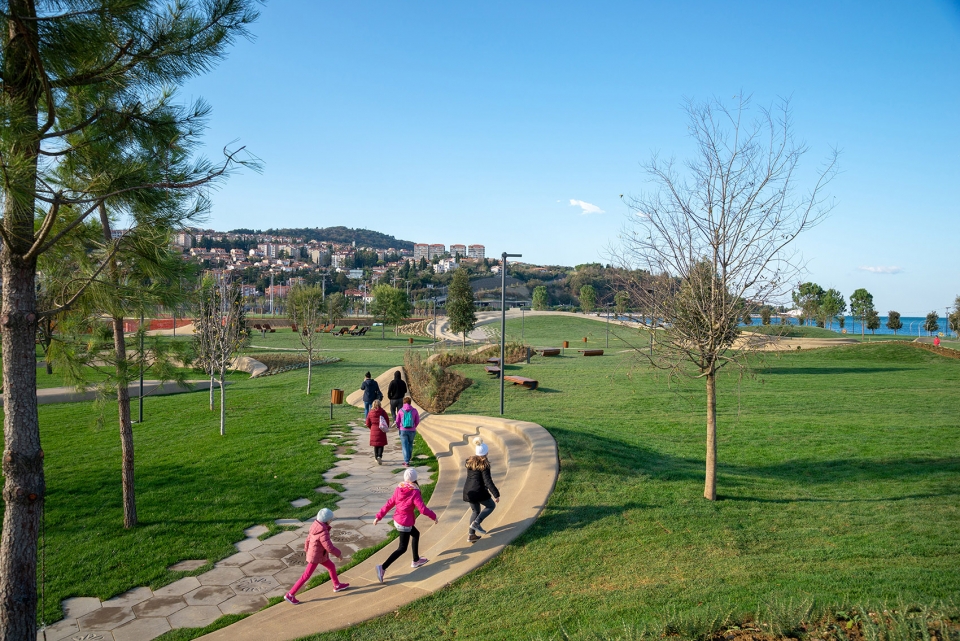
▼場(chǎng)地平面圖, site plan
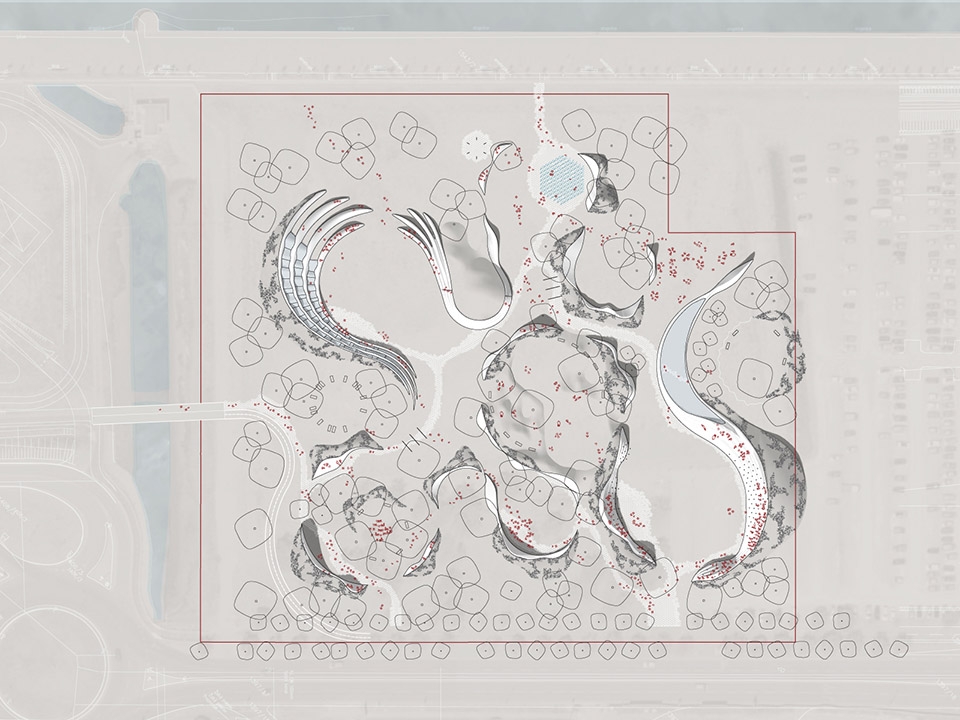
KOPER CENTRAL PARK
The Plan Awards, Landscape winner
project: Koper Central Park
type: invited competition, first prize
year: 2016
status: built 2018
site: 26.000 m2
cost: 3.000.000 EUR
client: Koper Municipality
location: Koper, Slovenia
coordinates: 45°32’38.6″N 13°43’23.8″E
architecture: ENOTA
project team: Dean Lah, Milan Tomac, Gregor Vreš, Peter Karba, Polona Rupar?i?, Peter Sovinc, Jakob Kajzer, Carlos Cuenca Solana, Nuša Završnik Šilec, Sara Me?ik, Eva Tomac, Goran Djoki?
greenery Spicy Garden
collaborators: Ivan Ramšak s.p. (structural engineering), Nom biro (mechanical services), Nom biro (electrical installations)
photography: Miran Kambi?
來源:本文轉(zhuǎn)載自谷德設(shè)計(jì)網(wǎng)(gooood)
我們重在分享,尊重原創(chuàng)。如涉及作品內(nèi)容、版權(quán)和其它問題,請(qǐng)與本網(wǎng)聯(lián)系,我們將在第一時(shí)間刪除內(nèi)容!
- 時(shí)間 2019-02-25 /
- 作者 gooood /


